While field spaniels remain rare in this country—they ranked 140th on the AKC's breed registration list in 2013—there is a growing recognition among spaniel-loving hunters that this is, for the most part, a healthy, good looking and versatile breed with an excellent desire to hunt and a really good nose.
"They have fabulous noses and hunt at a speed that is comfortable to walk behind," says Karen Balinski. "They do a good job of hunting in a variety of covers from thick to wide open and they automatically adjust their style, speed and range to whatever type of cover you are hunting.
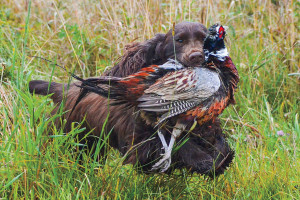 "They will hunt all day with enthusiasm. They also have an on/off switch, which means they are easy to live with. They are typically slower and more methodical in the field than, say, springers, but the trade-off is that they find birds that other dogs have passed."
"They will hunt all day with enthusiasm. They also have an on/off switch, which means they are easy to live with. They are typically slower and more methodical in the field than, say, springers, but the trade-off is that they find birds that other dogs have passed."
Neal Winters also cites the field spaniel's ability to find birds as one of the traits that makes the breed special as a hunting dog. "They have truly exceptional noses," he says. "I've often seen experienced dogs begin scenting birds when they were 50 feet away from them, depending on the wind. They don't overrun their nose and with their soft mouths and solid work ethics, they quickly locate and bring downed birds to hand.
"We live and hunt mainly in the upper Midwest where a lot of hunting is on preserves, 'put and take' public grounds or small farms. Since field spaniels were developed to hunt the blackthorn of the English midlands, they adapt well to these conditions and excel working in tight cover or small fields. But they also work equally well on wild pheasants in the open prairies and fields of South Dakota."
Soft Touch
Mike Gregory says that one of the reasons he has field spaniels is because he likes the idea of living and hunting with a rare breed. Another virtue of the breed, he said, is that field spaniels have not split into "field" and "show" types, which means he can take his good-looking hunting dogs to conformation shows and have a reasonable chance of winning.
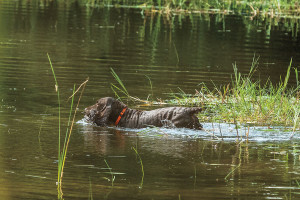 In addition, field spaniels have a hunting style that Gregory appreciates. "They are slower than a field-bred springer," he notes. "'Deliberate' would be a good way to describe their style. They cover the field until they scent game and then they go right for it. They are also willing retrievers from both land and water. But they do have their training quirks.
In addition, field spaniels have a hunting style that Gregory appreciates. "They are slower than a field-bred springer," he notes. "'Deliberate' would be a good way to describe their style. They cover the field until they scent game and then they go right for it. They are also willing retrievers from both land and water. But they do have their training quirks.
"They seem to have their own ideas on how to hunt, which aren't always the same as the ideas of the person carrying the shotgun. They are a bit 'soft' and do not respond well to harsh corrections. You can use an electronic collar on them but only on very low settings and quite candidly, the dogs don't like them.
"I do train a forced retrieve on my dogs just so there's no question about their duties. Once they learn their responsibilities, they are pretty solid. 'Firm but fair' is good advice when training a field spaniel."
Pam Boyer made the switch to field spaniels from American water spaniels when a friend became ill and wasn't able to raise a field spaniel pup he had coming from a breeding. The field spaniel proved to be adept at finding game as well as retrieving from land and water and did it naturally.
Pam and her husband also loved the calmer temperament of the field spaniel. "As our AWS got older and was no longer able to hunt, we really started to realize the amazing talents of fields," she says. "Their game finding and swimming could not have been better and over the years, we discovered that the dogs remained in gun range even as puppies. But we also discovered that training a field was very different from many other breeds we'd been exposed to.
"Fields take to the birds and retrieving very quickly but you can't put any pressure on a young dog. Field spaniels don't want to disobey. They try very hard to follow the rules and do what makes you happy. They were never bred as a competitive trial dog but as a companion hunting dog, which means they're not as hard-running as a springer. They're great house dogs and are happy to nap on the couch until the shotguns and the hunting vests come out. Then it's chaos, so be ready!"
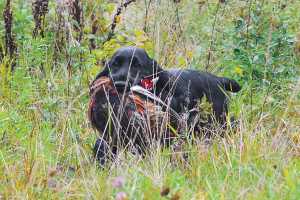 Neal Winters says that training a field spaniel requires an open mind and the ability to use a variety of techniques. The bigger the trainer's "bag of tricks" the more successful he will be. "Field spaniels have softer dispositions than many other hunting breeds and they do not tolerate heavy-handed training techniques," Winters notes. "Often, a stern word is enough to stop unwanted behavior or produce the desired response.
Neal Winters says that training a field spaniel requires an open mind and the ability to use a variety of techniques. The bigger the trainer's "bag of tricks" the more successful he will be. "Field spaniels have softer dispositions than many other hunting breeds and they do not tolerate heavy-handed training techniques," Winters notes. "Often, a stern word is enough to stop unwanted behavior or produce the desired response.
"While patience, consistency and persistence are the keys to training, field spaniels are intelligent dogs and repeated drilling is unnecessary. However, they can be creative and will find innovative ways to solve training challenges. I often hear Frank Sinatra singing 'I did it my way' when I'm working with one of my field spaniels.
"They adapt well to most new situations," Winters continues. "Field spaniels and kids go together very well but, as with any other breed, you need to teach your kids how to make it clear that they rank above the dog in the 'pack order.' These are social, people-oriented dogs who want to be with people, which makes them poor kennel dogs. But as is the case with any dog, they need to be taught to mind their manners. Left to their own devices, they can find ways to entertain themselves that may not always be appreciated.
"In other words, they need a job. Field work, of course, is the ideal outlet for their energy but some of the other dog sports like obedience, rally or agility also work well when field work is not particularly appealing like during the winter in my part of the country. Even going for walks with you or playing with the kids seems to work for them."
Don't Force It
Karen Balinski also notes that the breed's soft temperament can be an issue in training a field spaniel. "They are a soft, sensitive breed but they can be stubborn and they get bored very easily," she says. "This combination can get quite frustrating at times. If you try to use only force and get heavy-handed, they will simply shut down. The key is making training fair, consistent and understandable for the dog.
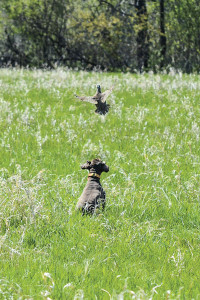 "I do use the e-collar in certain training situations but they are smart and they get collar-wise very easily. If you get overzealous with the e-collar, you will just wind up with a dog that refuses to work. While there is no field/show split in the breed, there are some fields that will not be great hunting dogs. Some have zero interest in birds and I've seen others that lacked the ability to mark and find game. I've also seen a few that despite fair and consistent training just become unraveled in the field.
"I do use the e-collar in certain training situations but they are smart and they get collar-wise very easily. If you get overzealous with the e-collar, you will just wind up with a dog that refuses to work. While there is no field/show split in the breed, there are some fields that will not be great hunting dogs. Some have zero interest in birds and I've seen others that lacked the ability to mark and find game. I've also seen a few that despite fair and consistent training just become unraveled in the field.
"The problem is that it's such a rare breed that the gene pool is small and that makes it difficult to breed away from undesirable traits while getting desirable traits into the breed. Very few people hunt with their fields so often we don't know how good or poor the hunting instinct is in a particular line. I've heard some breeders say that all fields can hunt but this is not true. Some can be phenomenal in the field while others can be a complete dud."
Boyer says that in her opinion, the field spaniel is an ideal dog for a beginning trainer. "They really don't need a lot of training to be effective hunting dogs. I have had many first time hunting dog owners who are very happy with the results they've achieved training their dogs themselves. However, I am concerned that we may be losing that 'gentleman's hunting dog' temperament as some are breeding for a harder-driving dog, more like the field springer. While this is great for springer enthusiasts, it will change a breed this small and we will lose that extremely easy-to-train temperament."
Hunt for Show
Winters notes owning a rare breed has both benefits and drawbacks. "When you look in the catalog at spaniel hunt tests, you'll see that the vast majority of field spaniels running in these tests are also conformation champions. So hunting dogs show and show dogs hunt, which is a wonderful situation for those who like a dog that meets both the conformation and performance standards for the breed.
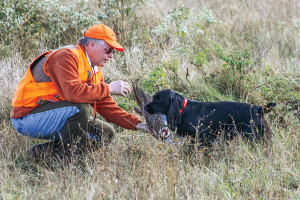 "In a practical sense, this means that any litter of field spaniel pups can produce hunting prospects. Unfortunately, very few field spaniels breeders are active in field work so looking at pedigrees to help select a hunting pup is not usually very productive. The best approach, if you can, is to evaluate a pup's prey drive.
"In a practical sense, this means that any litter of field spaniel pups can produce hunting prospects. Unfortunately, very few field spaniels breeders are active in field work so looking at pedigrees to help select a hunting pup is not usually very productive. The best approach, if you can, is to evaluate a pup's prey drive.
"The other drawback is the lack of puppy availability. There are around 100 to 120 field spaniel puppies born in the U.S. in a given year. Looking for a field spaniel requires more patience than with many other sporting breeds but the wait is worth it.
"If you think this is the breed for you, your search should start early and you should talk with the breeders on the Field Spaniel Society of America's Breeder Referral List."
Airedale
In the beginning, Airedales were hunting dogs. The working class people in the West Riding of Yorkshire, who developed the breed, needed a dog that could scent game, had the size to be able to tackle larger animals and could be taught to retrieve. The answer to this need turned out to be the Airedale.
Click here to read more.
Braque Francais
![Braque Francais]()
In the days before France became known as the cradle of artists and the center of the fashion world, it was a superb upland hunting destination. The hills of the French countryside were planted with a variety of agricultural crops and the forests and mountains were teeming with wildlife. Grouse, pheasants and partridge were common in the farmlands and wild birds were a staple food for many rural families.
At the same time, pointing dogs were becoming more popular in Europe and a select group of French breeders set out to develop a breed that had the athleticism necessary to hunt hard all day and the instinct to point and retrieve birds. Using Spanish pointers and various European hounds as their root stock, these breeders began to develop dogs that embodied all of the qualities they desired.
The result of their efforts was the Braque Francais. The Braque became known for its keen determination and overwhelming desire to please its master. Careful breeding resulted in a dog that could be relied upon to obey commands in the field and hunt hard all day long, a dog that had intense prey drive and could also serve as a family companion, playing with the children, yet acting as a watchdog in the dark of night.
Click here to read more.
Curly-Coated Retriever
With textured curls and a sleek frame, the curly-coated retriever often triggers double-takes from onlookers. At a distance, the curly-coated retriever is often mistakenly identified as a Labrador because the curly shares the Lab's conformation and passion for finding, flushing and fetching gamebirds. But surprisingly, the curly was not descended from the Lab. Rather, the curly is thought to have been bred from the English water spaniel, the St. John's Newfoundland, the retrieving setter and the poodle, according to the American Kennel Club.
Up close, the curly is much different from a Labrador: Its coat is made up of short, stiff hairs tightly wound into ringlets covering the main body, the top of the head and the ears.
Click here to read more.
Flat-Coated Retriever
![Flat-Coated Retriever]()
Once upon a time, when English gamekeepers reigned supreme on the estates of the nobility, they needed a dog that could find and retrieve birds that might have been missed after a driven shoot. But their mortal enemies, poachers, also needed a dog to find and retrieve birds€¦only in their case, in the middle of the night. In both instances, for the law-abiding and lawbreaker alike, the flat-coated retriever was often the dog of choice.
For whichever task they were assigned, the dog needed to have an outstanding nose, be exceedingly biddable, and when they were working for the poachers, be fast and agile enough to escape the bull mastiffs the gamekeepers employed to patrol the estate during the hours of darkness. These traits, still present in the breed today, are a not-so-well-kept secret for this relatively rare retriever breed, which has achieved the highest levels of success in all of the AKC's dog sports except for retriever field trials. Flat-coats were in 90th place in 2011 on the American Kennel Club's 'popularity list ' of the 173 breeds recognized by the AKC.
Click here to read more.
French Brittany
'Some French Brittanys can be drama queens when training pressure is applied, ' notes Jim Keller from Keller Gun Dog Kennels near Lincoln, Neb. 'By 'drama queen' I mean this breed sometimes tends to overreact with a lot of emotional outbursts when specific behavior is required of them.
'For example, when being taught to force fetch, some French Brittanys will squeal and squirm in an effort to get the trainer to leave them alone. And some trainers will back way off and let the dog have its way, ' Keller says.
Click here to read more.
Portugese Pointer
Ralph Fedele told me his first choice was a whippet, not a Portuguese pointer. He'd been a bird hunter in a previous life, before children. He now wanted a small dog with short hair — less mess in the house — that was good with kids. Then his wife got into the act.
'My wife said, 'Look at this dog I just happened to come across on the internet,' ' Fedele recalls. 'I looked at the pictures and said, 'That's the dog. Let's call this guy and get that dog.' My wife, just completely coincidentally, is Portuguese, although she had no prior experience with the dogs. '
Click here to read more.
Standard Poodle
From the Middle Ages, Europeans have always considered the standard poodle a hunting dog. According to Canadian breed historian Emily Cain, Europeans categorized it as a spaniel. However, the French breed name, caniche, comes from chien canard, or 'duck dog, ' so they have also classified it a retriever.
Click here to read more.
Irish Red and White Setter
If you ask the owner of an Irish Red and White Setter what makes these dogs special, almost uniformly the answer is, 'They are natural pointers. ' Many say their dogs have earned a junior hunter title with absolutely no training at all and never having had any exposure to birds prior to the time they started running in the tests.
Click here to read more.
German Shorthaired Pointer
German shorthaired pointers have been particularly popular in the U.S. with gamebird hunters looking for a do-it-all versatile gun dog. There are approximately 10,000 German shorthairs annually registered with the American Kennel Club and the United Kennel Club. Likewise, shorthairs are the dominant breed in NAVHDA and have produced top scores in Natural Ability, Utility, and Versatile Champion testing for the past several decades.
German shorthaired pointers are also one of the main dog breeds in many kinds of field trials and a variety of hunting contests. And all across North America, shorthairs are the common pointing breed for the average gamebird hunter just about anywhere there are gamebirds to be hunted.
Click here to read more.
Irish Water Spaniel
'Beannaithe ' (Blessed) is how the old Gaelic hunters in Ireland viewed the Shannon spaniel that later became known as the Irish water spaniel. Developed to retrieve waterfowl and upland game, the breed proved to be so versatile it could do just about anything except dance Irish jigs and reels. But there are those who contend that given proper instruction and the appropriate music, an IWS could probably master these intricate step dances, also.
Click here to read more.
Llewellin Setter
There's no sight more classic than a pair of gun dogs working a gamebird with one dog pointing and the other backing.
The canines in this case were two Llewellin setters on a South Dakota pheasant hunt last fall. The two dogs stood frozen with heads and tails high in a picture-perfect pose. As one of the hunters walked in to flush the pointed bird, two hens and one rooster rocketed out of the prairie grass. One well-placed shot brought down the long-tailed ringneck and one dog ran out, picked up and brought it in.
Click here to read more.
English Springer Spaniel
Leave the open country birds and serious waterfowling for the dogs that are bred for that kind of stuff, the pointing and retrieving breeds. Spaniels really shine for small-water ducking and thick-cover upland birds — bobwhite quail, woodcock, ruffed grouse€¦and, oh yes, pheasants.
If ever a dog was created to hunt pheasants, it is the springer spaniel. I simply can't understand why the breed isn't more popular, given the vast number of rooster hunters in the U.S., but there you go. The really good ones — and I had one like that — can be almost wizard-like in the way they approach the game.
Click here to read more.
American Water Spaniel
Developed by 19th-century market hunters in the Upper Midwest, the American water spaniel has always been a dual-purpose dog, equally talented for waterfowl and upland gamebird hunting. From the beginning and continuing to this day, AWS owners have been determined to maintain the breed's dual résumé. Ironically, that determination has prevented them from displaying the AWS' versatility in the field events of the American Kennel Club (AKC).
These events come in three distinct formats: one for pointing breeds, one for retrievers and one for spaniels. Thus, for a breed to participate, it must not only be AKC-recognized as a Sporting Group breed, but must also be grouped in one and only one of AKC's three classifications: pointing breed, retriever or spaniel. AKC doesn't allow dual classifications.
Click here to read more.
Weimaraner
The Weimaraner, from the beginning of its breed history more than 100 years ago, has been known as the 'Gray Ghost ' — a good nickname for a gun dog with a silvery coat and somewhat spooky-looking yellow-amber eyes. Originally developed in Germany at the court of Weimar (hence its name), the Weimaraner was successfully bred to be a versatile hunter of upland gamebirds, waterfowl, predators, and big game.
Click here to read more.






